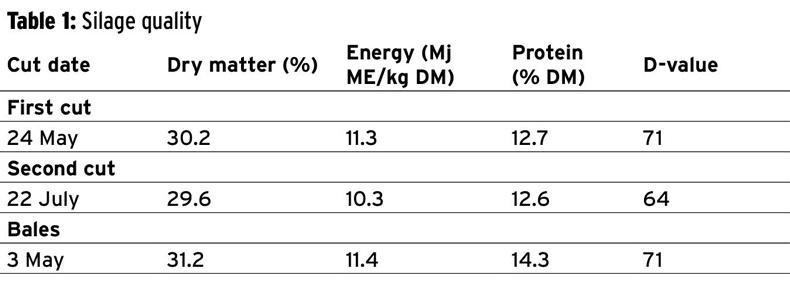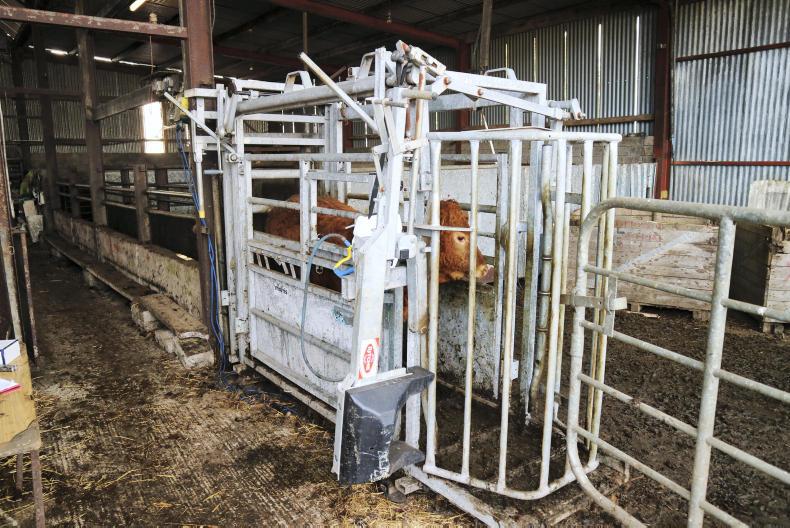I weighed all of the calves last week, just prior to weaning. At the same time, I weighed and condition-scored all cows in the herd. This allowed the herd to be ranked according to the best-performing cows and calves.
Condition scoring and weighing has also allowed me to group cows for the winter and match their feeding requirements accordingly.
Silage supplies are tight on the back of cows being housed much earlier than normal. In hindsight, some stronger calves should have been weaned off earlier and cows had their silage intake restricted.
However, delays in re-arranging cattle housing facilities prevented this from happening in time this year.
Cows with spring-born calves still suckling can go through a lot of silage quickly, so weaning is taking place this week.
I have a spread-out calving period, with calf birth dates ranging from 28 December 2016 through to 5 August 2017.
All calves are settled indoors and have received their pneumonia vaccinations. Weaning will be carried out simply by shutting the creep gates, with calves penned on a separate bedded area.
Tightening the calving period
I have bought into tightening the calving period and this year I delayed turning the bulls out with cows until 6 June.
Bulls ran with cows until September, with cows scanned on 28 September. With scanning able to pick up pregnant cows from five weeks after service, only cows bred by 24 August are being retained for next year.
From 65 cows put to the bull, 58 were in-calf at scanning. These have been bred to Angus and Limousin stock bulls.
A further 31 heifers were run with a newly purchased Angus bull, with 27 of these scanned in-calf, 21 of which held in the first four weeks of breeding.
Unfortunately, one of these animals has since died, leaving 27 in-calf heifers for next year.
Along with the 58 cows, there is potentially 86 to calve next spring.
My target is to get to 85 cows and calves on the ground each year, so we are not too far off this for next year as things stand.
Replacements
The majority of my current herd were purchased as maiden heifers. Although it is difficult to know the exact back-breeding, most cows are Limousin and Angus bred, with some dairy influence.
In recent times, the numbers of purchased heifers that do not work out has been too high, particularly considering how much they cost to buy.
So I am now moving towards breeding all replacements from my own cows and focusing on producing a Limousin-cross-Angus cow.
2018 replacements
I have 26 heifer calves born from March through to May 2017 which will be ready for breeding next June. They averaged 267kg on 2 November, leaving an average weight gain requirement of 0.4kg per day to meet a target breeding weight of 420kg next June.
After weaning, they are being fed first-cut baled silage and 1kg/day of meal. This should support a daily weight gain of 0.7kg per day.
They will be held on this diet until the end of December. At that point, they will be weighed again and hopefully taken off meal altogether.
I would rather have them on a higher growth rate now and ease off feeding next spring, rather than heifers falling behind target and having to play catch up.
I am finishing bull calves as steers. They are currently averaging 289kg and will be fed at a rate of 1.5kg/day also, along with first-cut baled silage. Silage quality is outlined in Table 1.

Condition-scoring cows
After condition scoring, all cows ended up with an average body condition score (BCS) of 2.75, which is ideal, as I want cows calving down in the 2.5 to 3.0 range.
As I will be calving from March onwards and expect cows to get out to grass shortly after calving, I can afford to let more cows go towards the thinner end of this range.
There were 14 cows with a BCS greater than 3.0, which can be penned separately, while a further four cows had a BCS 2.0 and will also need separating for ad-lib silage feeding.
All cows are being fed second-cut silage. Those within the ideal BCS range can be restricted to 24kg/day and gradually increased to ad-lib silage by calving, at which point they should be eating 35kg/day.
My cows averaged 667kg at weaning. Although I have 86 cows in-calf and have a target of 85 calved next year, I am considering reducing this number by culling some of the heavier poorer-performing cows.
These cows will cost more to feed over the winter and are the least efficient when it comes to calf weights.
The 10 poorest-performing cows averaged 733kg and weaned just 34% of their body weight, compared with the top 10 cows weaning 51% of their body weight.
With limited silage stocks, it makes more sense to fatten these passengers. To further reduce silage demand once cows are weaned and dried off, I also intend turning some cows back out to grass on firmer land with heavy grass covers.
Finishing cattle
Steers born in 2016 will be finished this winter. Since housing on 22 September, performance has been good at 1.46kg/day. Performance at grass this year averaged 0.8kg/day. The heaviest steers over 600kg are being fed first-cut bale silage along with 5kg of a 12% protein ration during a short finishing period. The remaining steers range from 500kg to 550kg liveweight and are being fed first-cut pit silage along with a 3kg of a 16% CP grower blend. This will keep them growing before being moved on to the finishing blend as they reach the 600kg mark.






 This is a subscriber-only article
This is a subscriber-only article










SHARING OPTIONS: